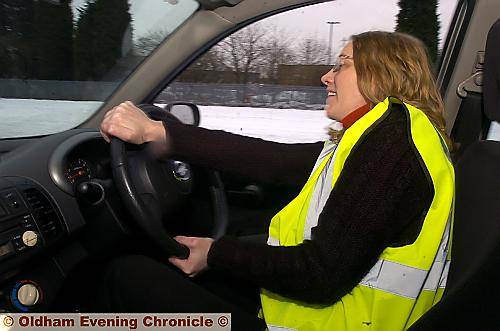Karen takes her car for a spin...
Reporter: Karen Doherty
Date published: 19 January 2010

OUR intrepid reporter Karen fights to control her car
OLDHAM town centre ground to a halt when the first blanket of heavy snow signalled the start of a winter whiteout. And an accident involving 25 vehicles on black ice the A627M last week highlighted the dangers of driving in a big freeze.
But with more people than ever relying on the car to get to work or the kids to school — and more bad weather forecast — the Chronicle sent reporter Karen Doherty to a snow driving boot camp.
EVERY driver knows that stomach-in-mouth feeling when you skid on ice.
Ramp that up by 10, throw in a few obstacles, add an ex-army driving instructor and you have got the snow-driving awareness course at commercial driving centre Mantra Learning at Greengate.
Mantra’s 300ft skid pad — with safety buffers, thankfully — is the ideal place for people to learn everything from tips on slide control to stopping distances for their own car.
Sessions for the public and businesses last between one and two hours — and apparently my little Nissan Micra was an ideal learning car.
It is light, which means it’s easier to skid, according to former Grenadier John Knaggs (43) who has taught troops to drive in everything from deserts to blizzards.
He explained: “With snow an infrequent occurrence in these parts, we don’t get much opportunity to driving in what can be very dangerous conditions.
“Accidents are often caused by people’s lack of awareness and confidence in driving on snow and ice,” he explained.
“Each vehicle is different, so it’s important to understand how yours reacts in different conditions. That’s the beauty of this course; you can practice manoeuvres in a controlled environment.
“We also provide you with all the tricks of the trade, such as putting a bag of sand in your boot to improve traction in a rear-wheel-drive car.
But we also tell you the truth: it could be your vehicle is best parked-up until conditions improve.”
I’ve always fancied myself as an undiscovered Jenson Button and couldn’t wait to have a go on the slalom course on snow, compacted over ice.
Setting off in the recommended second gear, my confidence about driving in wintry conditions soon took a dent as I skidded close to traffic cones while John urged me to go faster.
“It’s getting used to not feeling petrified when you feel the car skidding,” said LGV instructor John.
“Ninety per cent of accidents happen when people get into a slip, the back end goes and they don’t know what to do.”
Resisting the urge to slam on the brakes (which will simply lock the wheels and make you skid more) and instead using the clutch soon helped my control.
I was also interpreting the well-known advice “steer into the skid” wrongly by turning the way the front of the car was going, rather than the back.
It is also important not to over-compensate.
The idea is to straighten the wheels, otherwise you could end up in a spin.
Thankfully, most of us will never have to contend with the treacherous conditions John faced in Germany, driving at night in snow with only a pair of goggles between himself and the elements.
But, he says, most accidents in snowy weather are down to a lack of planning and awareness: not leaving enough space between you and the vehicle in front, failing to anticipate conditions if you are turning into a side road (which may be ungritted and much more slippery), not realising that it might take longer to pull into a gap in traffic, and so on.
And while having a bigger car might give the illusion of being in a safety bubble, it’s not necessarily so.
“People think when they have got a 4x4 they can go anywhere, do anything and brake 10 times faster than anyone else,” said John.
“While they can get through the snow, they can’t stop any quicker. In fact it will probably take them a greater distance to stop, because the vehicle is heavier.”
Inevitably, conditions will be too much for even the most knowledgeable driver — reinforcing messages not to drive unless absolutely necessary.
Advanced instructor Joanne Morris, who supports John, added: “If you hit black ice, particularly down hill, there isn’t a lot you can do about it.
“People brake and tense up in those circumstances — but the best thing to do is to relax and wait for an impact, if there is going to be one...”
In the end, the weather usually wins...
Top tips for driving in snow and ice
When road are slippery it takes up to 10 times longer to stop
:: Drop your speed and give yourself more time to slow down. Keep well back from the vehicle in front.
:: Drive with care, even if roads have been treated. In very cold weather even salt water from gritted roads can freeze.
:: If you start to skid, depress the clutch. Don’t brake — it will just lock-up your wheels and cause you to skid more.
:: Clear snow from your roof before you set off, so it doesn’t slip forward on to your windscreen when you stop.
:: If your tyres are making virtually no sound, you could be driving on black ice. Slow down
:: Anti-lock braking has very little effect on, ice, snow or gravel, so don’t think having it will help you to drive faster or less carefully.




